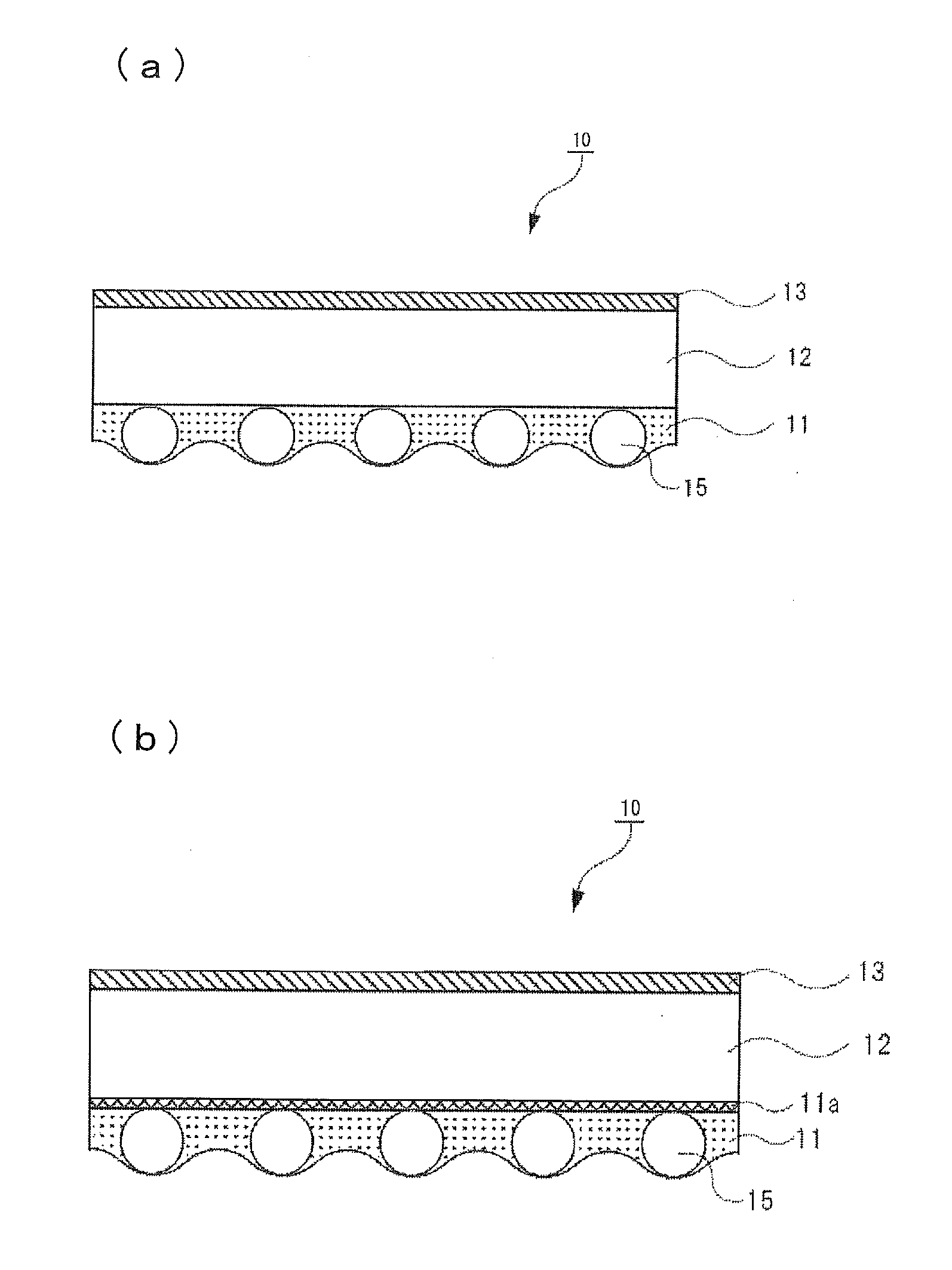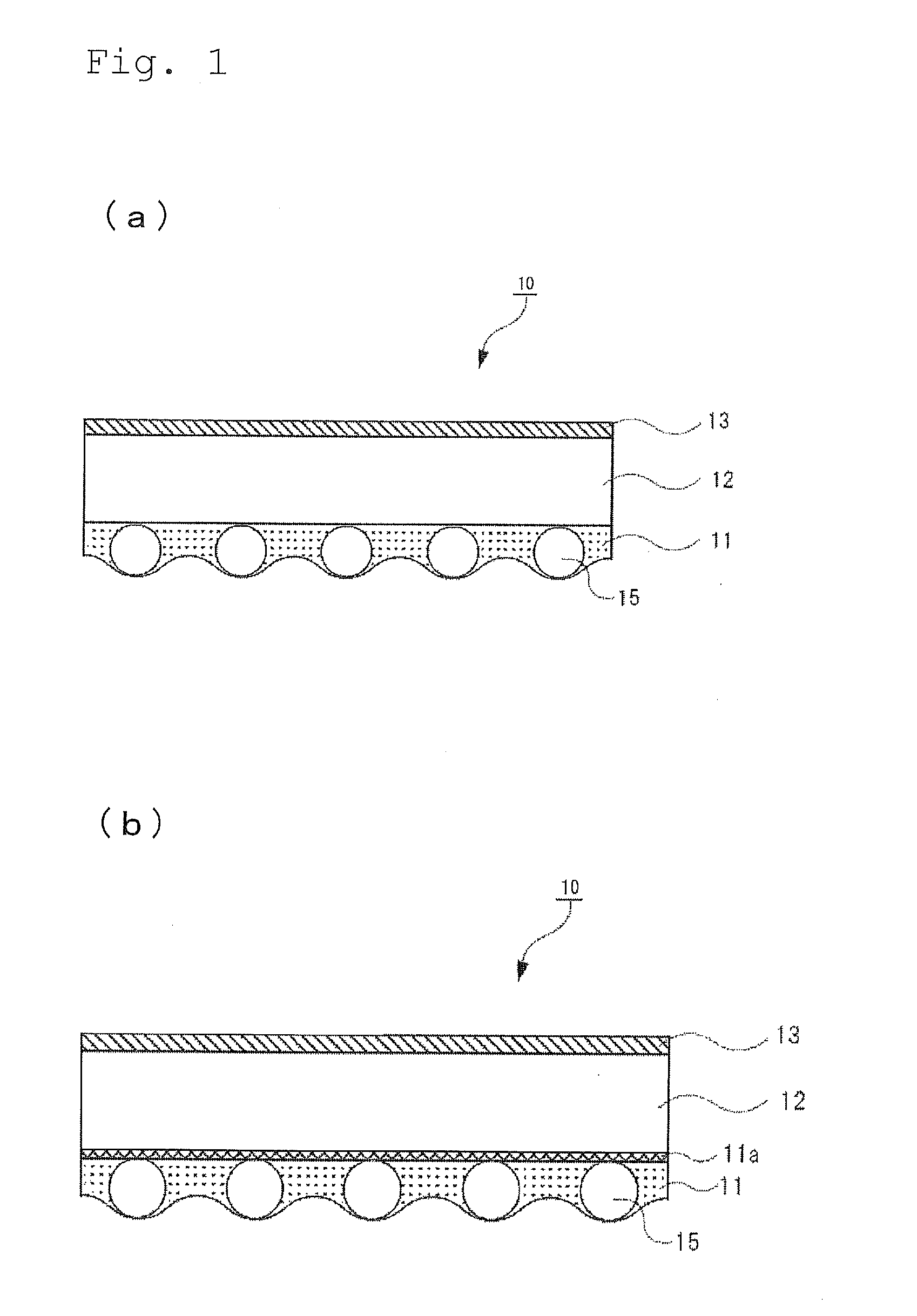Sheet for illumination, printed matter for illumination, method of producing printed matter for illumination, and illumination signboard
- Summary
- Abstract
- Description
- Claims
- Application Information
AI Technical Summary
Benefits of technology
Problems solved by technology
Method used
Image
Examples
first embodiment
[0048]FIG. 1(a) is a sectional view illustrating an example of a sheet for illumination according to a first embodiment of the present invention. As illustrated in FIG. 1(a), a sheet 10 for illumination of the first embodiment of the present invention is formed by laminating a mat layer 11, a support 12, and an easily-adhesive layer 13, and the surface of the mat layer has certain unevenness. It is preferable that the mat layer 11 is a hard coat layer having hardness and scratch resistance. In this manner, it is possible to prevent the sheet 10 for illumination from being damaged. An image layer is formed by an ink composition being ejected onto the easily-adhesive layer 13. The easily-adhesive layer 13 improves adhesiveness between the support 12 and the image layer.
[0049]The mat layer includes a silicon-containing resin, a matting agent, and a surfactant. The silicon-containing resin contains a condensate obtained by condensing a silane coupling agent. In addition, the silane coup...
second embodiment
[0176]A second embodiment is the same as the first embodiment except that the mat layer contains a matting agent having a particle diameter of 0.4 μm to 3 μm and a binder and a refractive index difference between the matting agent and the binder is 0.1 or less. That is, the support, the intermediate layer, and the easily adhesive layer of the first embodiment can be used for a support, an intermediate layer, and an easily adhesive layer in a sheet for illumination of the second embodiment and the preferable ranges are the same as each other.
[0177]A difference in the refractive index between the matting agent and the binder is preferably 0.1 or less, more preferably 0.08 or less, and still more preferably 0.05 or less. When the difference in the refractive index is in the above-described range, the haze value can be adjusted not to be excessively large. The haze value of the mat layer may be 35% or less, preferably in the range of 3% to 30%, more preferably in the range of 6% to 30%,...
example 1
Preparation of Sheet for Illumination
[0230][Preparation of Support]
[0231]Polyethylene terephthalate (hereinafter, referred to as “PET”) resin in which a Ti compound was polycondensed as a catalyst and whose intrinsic viscosity was 0.66 was dried to have a moisture content of 50 ppm or less and dissolved in an extruder at which a set heater temperature was in the range of 280° C. to 300° C. The dissolved PET resin was ejected onto a chill roll electrostatically applied from a die portion, thereby obtaining an amorphous base. The obtained amorphous base was stretched at a stretch ratio of 3.1 times in the base scanning direction and stretched at a stretch ratio of 3.8 times in the width direction, thereby obtaining a PET support having a thickness of 250 μm.
[0232][Preparation of Easily Adhesive Layer]
[0233]After a corona discharge treatment was performed on a PET support under the condition of 730 J / m2, the corona-treated surface side was coated with a coating liquid A described below...
PUM
| Property | Measurement | Unit |
|---|---|---|
| Temperature | aaaaa | aaaaa |
| Length | aaaaa | aaaaa |
| Fraction | aaaaa | aaaaa |
Abstract
Description
Claims
Application Information
 Login to View More
Login to View More - R&D
- Intellectual Property
- Life Sciences
- Materials
- Tech Scout
- Unparalleled Data Quality
- Higher Quality Content
- 60% Fewer Hallucinations
Browse by: Latest US Patents, China's latest patents, Technical Efficacy Thesaurus, Application Domain, Technology Topic, Popular Technical Reports.
© 2025 PatSnap. All rights reserved.Legal|Privacy policy|Modern Slavery Act Transparency Statement|Sitemap|About US| Contact US: help@patsnap.com



